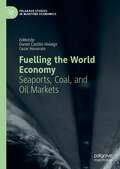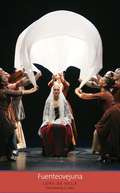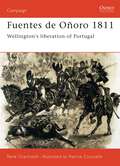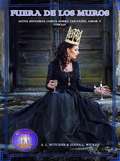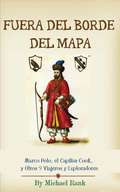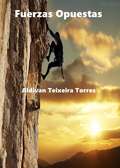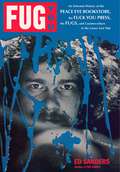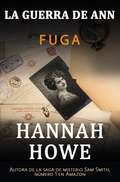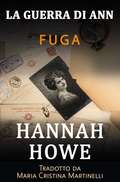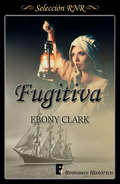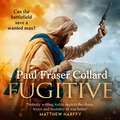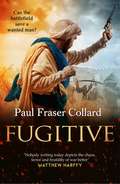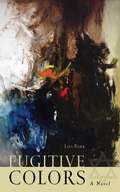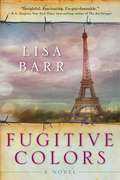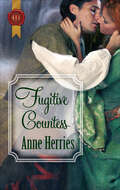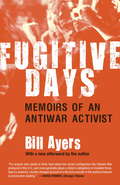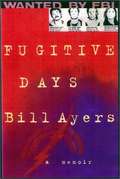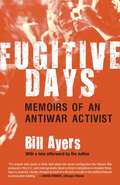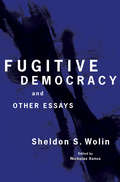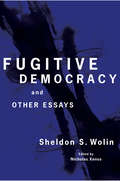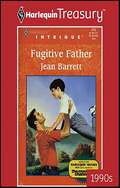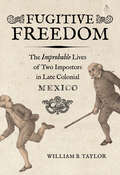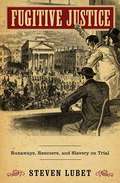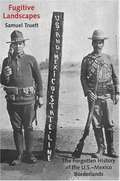- Table View
- List View
Fuelling the World Economy: Seaports, Coal, and Oil Markets (Palgrave Studies in Maritime Economics)
by Daniel Castillo Hidalgo Cezar HonoratoThis book explores the functioning of coal markets and their influence on ports and maritime economics since the second half of the nineteenth century. Each chapter includes case studies from different parts of the world, explaining the role played by coal in the expansion of the shipping industry. This book also explores regions usually neglected by the mainstream scholarly literature in this field. The relationship between steam engine technology and imperial expansion, how the emergence of global security was driven by maritime technological revolutions, and the connection between global seaports and the spread of global economic and political systems are also discussed.This book aims to highlight the important role seaports and fuel markets played in the evolution of international commercial flows and activities. Fuelling the World Economy will be useful for historians, economists, and geographers interested in maritime and energy issues, as well as researchers interested in transport and technology.
Fuenteovejuna
by Lope De VegaLope de Vega "single-handedly created the Spanish national theatre," writes Roberto González Echevarría in the introduction to this new translation of Fuenteovejuna. Often compared to Shakespeare, Molière, and Racine, Lope is widely considered the greatest of all Spanish playwrights, and Fuenteovejuna (The Sheep Well) is among the most important Spanish Golden Age plays. Written in 1614, Fuenteovejuna centers on the decision of an entire village to admit to the premeditated murder of a tyrannical ruler. Lope masterfully employs the tragicomic conventions of the Spanishcomediaas he leavens the central dilemma of the peasant lovers, Laurencia and Frondoso, with the shenanigans of Mengo, thegraciosoor clown. Based on an actual historical incident,Fuenteovejuna offers a paean to collective responsibility and affirmation of the timeless values of justice and kindness. Translator G.J. Racz preserves the nuanced voice and structure of Lope de Vega's text in this first English translation in analogical meter and rhyme. Roberto González Echevarría surveys the history ofFuenteovejuna, as well as Lope's enormous literary output and indelible cultural imprint. Racz's compelling translation and González Echevarría's rich framework bring this timeless Golden Age drama alive for a new generation of readers and performers.
Fuentes de Oñoro 1811
by Rene Chartrand Patrice CourcelleThis Osprey title examines the crucial campaign culminating in the hard-fought battle that finally drove the French from Portugal during the Napoleonic Wars (1799-1815). In October 1810 the Allied position in Portugal appeared precarious. Despite defeating Marshal Masséna's French army at Bussaco, Wellington had been forced to retreat to within a few miles of Lisbon. Here the French encountered a massive line of fortifications stretching from the River Tagus to the sea. Built amid great secrecy and on Wellington's specific orders, these Lines of Torres Vedras were the French high-water mark. In February, with his army on the point of starvation, Masséna was forced to retreat and the scene was set for the climactic action of Fuentes de Oñoro.
Fuera de los Muros
by A. L. Butcher y Diana L. WickerCuando la guerra llegue a sus puertas, ¿quiénes sucumbirán ante la catástrofe? Una historia corta sobre la determinación de una mujer durante tiempos de guerra Ganadora del premio “Chill with a Book” otorgado por Chill Awards.
Fuera del Borde del Mapa: Marco Polo, el Capitán Cook, y Otros 9 Viajeros y Exploradores
by Michael Rank Denise TarudDescripción del libro: Del autor #1 del bestseller Los Mayores Generales de la Historia, llega un nuevo y fascinante libro sobre los mayores exploradores en la historia y cómo sus descubrimientos moldearon el mundo moderno. Ya fuera Rabban Bar Sauma, el monje chino del siglo XIII a quien los mongoles encargaron viajar a Occidente para crear una alianza militar contra el Islam; Marco Polo, quien abrió una ventana para Europa hacia el Este; o el Capitán James Cook, cuyos viajes marítimos de descubrimiento crearon la economía global del siglo XXI, cada uno de estos exploradores tuvo un indeleble impacto sobre la sociedad moderna. Este libro tratará de los 11 mayores exploradores en la historia. Algunos viajaron por piedad religiosa, como en el caso de Ibn Battuta, quien viajó desde África del Norte hacia Indonesia en los 1300s, visitando todo lugar de peregrinaje islámico en el camino -y convirtiéndose en consejero de más de 30 jefes de estado. Otros viajaron por ganancias, como fue el caso de Fernando de Magallanes, quien quería consolidar el dominio de España sobre el comercio de especies. Otros viajaron por la simple fascinación de la aventura. Como el explorador victoriano Richard Francis Burton, quien aprendió 29 idiomas, hizo el peregrinaje a Meca en forma secreta como musulmán, y escribió 50 libros sobre diversos temas desde la traducción del Kama Sutra hasta un manual sobre ejercicios de bayoneta. Aun así, otros viajaron por descubrimiento, como Ernest Shackleton, quien dirigió dos docenas de hombres hacia el extremo sur del mundo en un intento por cruzar la Antártica a pie. Cualquiera que fuera su razón para el descubrimiento, estos exploradores aun hoy nos inspiran a ir más allá de los límites del logro humano -y descubrir algo sobre nosotros mismos en el intento.
Fuerzas opuestas
by Tamara Aymerich Correa Aldivan Teixeira Torres“Fuerzas Opuestas” se presenta como una alternativa para superar la gran dualidad existente en cada uno de nosotros. Cuantas veces, en la vida, no nos encontramos con situaciones en las que ambas alternativa presentan puntos favorables y desfavorables y escoger una se convierte en un verdadero martirio. Debemos aprender a reflexionar y a preguntarnos cual es el verdadero camino que hay que seguir y las consecuencias resultantes de esa elección. Por eso, necesitamos reunir las “fuerzas opuestas“ de nuestras vidas y hacer que produzcan frutos de nuestras vidas. Así, podremos alcanzar la tan añorada felicidad. En lo relativo al aspecto del libro, podemos decir que surgió a partir de un grito que oí en la gruta de la desesperación. Este grito fue la causa de todas las aventuras narradas en el libro. Una vez cumplida la misión, espero haber alcanzado mi mayor objetivo, que es hacer soñar aunque solo sea a una persona. Esto es lo que se propone a pesar de que vivimos en un mundo lleno de violencia, crueldad e injusticias. Las “fuerzas opuestas” nunca serán las mismas después de su publicación y no veo la hora de iniciar una nueva aventura al lado de los lectores que se lo propongan.
Fug You: An Informal History of the Peace Eye Bookstore, the Fuck You Press, the Fugs, and Counterculture in the Lower East Side
by Ed SandersFug Youis Ed Sanders's unapologetic and often hilarious account of eight key years of "total assault on the culture," to quote his novelist friend William S. Burroughs. Fug Youtraces the flowering years of New York's downtown bohemia in the sixties, starting with the marketing problems presented by publishingFuck You / A Magazine of the Arts, as it faced the aboveground's scrutiny, and leading to Sanders's arrest after a raid on his Peace Eye Bookstore. The memoir also traces the career of the Fugs--formed in 1964 by Sanders and his neighbor, the legendary Tuli Kupferberg (called "the world's oldest living hippie" by Allen Ginsberg)--as Sanders strives to find a home for this famous postmodern, innovative anarcho-folk-rock band in the world of record labels.
Fuga
by Hannah HoweMarzo de 1945. Tras seis años marcados por la sangre y las lágrimas, la guerra estaba a punto de terminar. Sin embargo, para los prisioneros de guerra alemanes que estaban encarcelados en Island Farm, el campamento 198, el fin podría no estar tan cerca, por lo que decidieron escapar. Mientras todos huían a cualquier parte, uno de ellos, Kurt Schneider, fue encontrado manchado de sangre y con una pistola en la mano. Además, una mujer yacía muerta a sus pies. Acusado de asesinato, parecía destinado a la horca. Sin embargo, Ann Morgan conocía a Kurt Schneider por sus trabajos supervisados en las granjas locales. Había desarrollado cierto afecto hacia el joven y no lo creía capaz de cometer un asesinato. ¿Podrá salvar Ann a Kurt y llevar al verdadero asesino ante la justicia? Mientras tanto, con su marido aún desaparecido, Ann se sintió atraída por un atractivo viudo, el detective Max Deveraux. Cuando llegue la hora, ¿podrá Ann vencer la tentación o hará algo de lo que se arrepienta?
Fuga: Un mistero della Guerra di Ann (La serie mystery La Guerra di Ann #4)
by Hannah HoweMarzo 1945. Dopo sei sanguinosi anni macchiati dalle lacrime, la guerra era quasi finita. Però, per i prigionieri di guerra tedeschi incarcerati nel Campo Prigionieri di Guerra 198 di Island Farm, la fine sembrava non arrivare mai – quindi avevano deciso di scappare. Mentre i prigionieri tedeschi si sparpagliavano in ogni direzione, uno di loro, Kurt Schneider, rimaneva indietro con le mani sporche di sangue e una pistola in mano. Non solo, ai suoi piedi c’era il cadavere di una donna. Accusato di omicidio, sembrava destinato alla forca. Ma Ann Morgan aveva incontrato Kurt Schneider durante i lavori supervisionati che lui aveva eseguito nelle fattorie locali e aveva iniziato ad apprezzare il giovane uomo e lo credeva incapace di commettere un omicidio. Sarebbe riuscita a salvare Kurt e a portare il vero omicida alla giustizia? Nel frattempo, con suo marito Emrys sempre disperso in azione, Ann si sentiva sempre più attratta dal bel vedovo, l’Ispettore Max Deveraux. Nell’impeto del momento sarebbe stata in grado di tenere a bada le proprie emozioni o avrebbe oltrepassato una linea che poteva causare solo rimorso e pentimento?
Fugitiva
by Ebony Clark-Es posible que yo no sepa nada del amor, Edwina. Pero si amara a una mujer... Le juro que el mundo entero lo sabría. Ella llevaría mi nombre escrito en la mirada. Llevaría mi marca allá donde fuera, mis besos en la piel y mi aliento en su boca... Cuando Edwina recibe la noticia de su compromiso con el Conde de Surrey, decide que solo existe una manera de evitar ese matrimonio. No está dispuesta a consentir en un compromiso impuesto con un hombre al que no conoce ni ama y por cuya fama de disoluto ya desprecia. Con esa firme convicción, emprenderá una desesperada huida que la conducirá directa a los brazos de un atractivo y desvergonzado aventurero llamado Bloody. Edwina se encontrará de pronto inmersa en una aventura que pondrá a prueba su valor y su lealtad y dividirá su corazón entre dos hombres: el Conde de Surrey, un perfecto caballero, arrogante y licencioso, fascinante sin embargo... Bloody, un ladrón, un granuja sin escrúpulos, aunque dispuesto a entregar su vida por ella. El Conde de Surrey había decidido que Edwina Brighton sería su esposa desde el mismo instante en que sus ojos se posaron sobre ella. Su querida madre le atormentaba exigiendo un nieto que continuara la estirpe y aunque eludía aquella responsabilidad como podía y rechazaba cortejar a cualquier joven casadera, antes nunca se había tomado tan en serio aquellos ruegos. Sin embargo, Edwina le había rechazado con tal rotundidad que era imposible ignorar el reto de doblegar su voluntad y su carácter indómito, aunque para ello tuviera que emplear los más descabellados ardides. -Es posible que yo no sepa nada del amor, Edwina. Pero si amara a una mujer# Le juro que el mundo entero lo sabría. -Bloody la miró con aquellos ojos penetrantes que parecían desnudar su alma-. Ella llevaría mi nombre escrito en la mirada. Llevaría mi marca allá donde fuera, mis besos en la piel y mi aliento en su boca. Si otro hombre se atreviera a mirarla sabría que ella me pertenece. Esa mujer sería mi dueña hasta que uno de los dos abandonase este mundo. Y por mi vida, que entonces cruzaría los mismísimos abismos para arrebatársela a la muerte. NOTA DE LA AUTORA: Lo mucho o lo poco que los derechos de autor de este libro puedan generar, lo necesitan mucho más los niños con cáncer a los que lleva diez años regalando sonrisas la Fundación Aladina. Por lo que la cantidad que la Editorial me liquide cuando corresponda, será íntegramente donada a dicha ONG. Porque hay muchas clases de amor y muchas formas de demostrarlo, esa será nuestra humilde aportación, para los niños, de parte de los protagonistas de esta historia... ¡¡Gracias!!
Fugitive (Jack Lark)
by Paul Fraser CollardIn this ninth action-packed Victorian military adventure, Paul Fraser Collard's roguish hero Jack Lark - soldier, leader, imposter - crosses borders once more as he pursues a brand-new adventure in Africa. After five years away, Jack Lark - soldier, leader, imposter - is once more called to fight . . .London, 1868. Jack has traded the battlefield for business, running a thriving club in the backstreets of Whitechapel. But this underworld has rules and when Jack refuses to comply, he finds himself up against the East End's most formidable criminal - with devastating consequences.A wanted man, Jack turns to his friend Macgregor, an ex-officer, treasure hunter and his ticket out of England. Together they join the British army on campaign across the tablelands of Abyssinia to the fortress of Magdala, a high-stakes mission to free British prisoners captured by the notorious Emperor Tewodros.But life on the run can turn dangerous, especially in a land ravaged by war . . . Praise for the Jack Lark series:'Brilliant' Bernard Cornwell'Enthralling' The Times 'Dusty deserts, showdowns under the blistering sun, bloodthirsty bandoleros, rough whisky and rougher men. Bullets fly, emotions run high and treachery abounds in The Lost Outlaw... an exceptionally entertaining historical action adventure' Matthew Harffy'I love a writer who wears his history lightly enough for the story he's telling to blaze across the pages like this. Jack Lark is an unforgettable new hero' Anthony Riches'You feel and experience all the emotions and the blood, sweat and tears that Jack does... I devoured it in one sitting' Parmenion Books'Expect ferocious, bloody action from the first page. Fast-paced, compelling, and with more villains than a Clint Eastwood classic, this unputdownable novel strongly reminded me of that legend of western writers, Louis L'Amour. A cracking read!' Ben Kane(P)2020 Headline Publishing Group Ltd
Fugitive (Jack Lark, Book 9)
by Paul Fraser Collard'Once again, Paul Fraser Collard proves he is a true master of action adventure' MATTHEW HARFFY'Like all the best vintages Jack Lark has aged to perfection. Scarred, battered and bloody, his story continues to enthral' ANTHONY RICHESRoguish hero Jack Lark - soldier, leader, imposter - crosses borders once more as he pursues a brand-new adventure in Africa. For fans of Bernard Cornwell's Sharpe series, Matthew Harffy and Patrick O'Brian.CAN THE BATTLEFIELD SAVE A WANTED MAN?London, 1868. Jack Lark is now a businessman, running a thriving club in the Whitechapel backstreets. But when he goes up against the East End's most notorious criminal, the consequences are devastating.A wanted man, Jack joins the British army on campaign across Abyssinia, a high-stakes mission that returns him to the battlefield and on to the fortress of Magdala where the formidable Emperor Tewodros has taken British subjects prisoner.But life on the run can turn dangerous, especially in a land ravaged by war . . .Praise for the Jack Lark series:'Brilliant' Bernard Cornwell'Enthralling' The Times'Bullets fly, emotions run high and treachery abounds' Matthew Harffy'Expect ferocious, bloody action from the first page' Ben Kane'You feel and experience all the emotions and the blood, sweat and tears that Jack does... I devoured it in one sitting' Parmenion Books
Fugitive (Jack Lark, Book 9)
by Paul Fraser Collard'Once again, Paul Fraser Collard proves he is a true master of action adventure' MATTHEW HARFFY'Like all the best vintages Jack Lark has aged to perfection. Scarred, battered and bloody, his story continues to enthral' ANTHONY RICHESRoguish hero Jack Lark - soldier, leader, imposter - crosses borders once more as he pursues a brand-new adventure in Africa. For fans of Bernard Cornwell's Sharpe series, Matthew Harffy and Patrick O'Brian.CAN THE BATTLEFIELD SAVE A WANTED MAN?London, 1868. Jack Lark is now a businessman, running a thriving club in the Whitechapel backstreets. But when he goes up against the East End's most notorious criminal, the consequences are devastating.A wanted man, Jack joins the British army on campaign across Abyssinia, a high-stakes mission that returns him to the battlefield and on to the fortress of Magdala where the formidable Emperor Tewodros has taken British subjects prisoner.But life on the run can turn dangerous, especially in a land ravaged by war . . .Praise for the Jack Lark series:'Brilliant' Bernard Cornwell'Enthralling'The Times'Bullets fly, emotions run high and treachery abounds' Matthew Harffy'Expect ferocious, bloody action from the first page' Ben Kane'You feel and experience all the emotions and the blood, sweat and tears that Jack does... I devoured it in one sitting'Parmenion Books
Fugitive Colors
by Lisa BarrDebut Historical Suspense Novel Wins IPPY Award for Best "Literary Fiction 2014"Stolen art, love, lust, deception, and revenge paint the pages of veteran journalist Lisa Barr's debut novel, Fugitive Colors, an un-put-down-able page-turner. Booklist calls the WWII era novel, "Masterfully conceived and crafted, Barr's dazzling debut novel has it all: passion and jealousy, intrigue and danger." Fugitive Colors asks the reader: How far would you go for your passion? Would you kill for it? Steal for it? Or go to any length to protect it?Hitler's War begins with the ruthless destruction of the avant-garde, but there is one young painter who refuses to let this happen. An accidental spy, Julian Klein, an idealistic American artist, leaves his religious upbringing for the artistic freedom of Paris in the early 1930s. Once he arrives in the "City of Light," he meets a young German artist, Felix von Bredow, whose larger-than-life personality overshadows his inferior artistic ability, and the handsome and gifted artist Rene Levi, whose colossal talent will later serve to destroy him. The trio quickly becomes best friends, inseparable, until two women get in the way-the immensely talented artist Adrienne, Rene's girlfriend with whom Julian secretly falls in love, and the stunning artist's model Charlotte, a prostitute-cum-muse, who manages to bring great men to their knees.Artistic and romantic jealousies abound, as the characters play out their passions against the backdrop of the Nazis' rise to power. Felix returns to Berlin, where his father, a blue-blooded Nazi, is instrumental in creating the master plan to destroy Germany's modern artists, and seeks his son's help. Bolstered by vengeance, Felix will lure his friends to Germany, an ill-fated move, which will forever change their lives. Twists and turns, destruction and obsession, loss and hope will keep you up at night, as you journey from Chicago to Paris, Berlin to New York. With passionate strokes of captivating prose, Barr proves that while paintings have a canvas, passion has a face-that once exposed, the haunting images will linger . . . long after you have closed the book.The Hollywood Film Festival awarded Fugitive Colors first prize for "Best Unpublished Manuscript" (Opus Magnum Discovery Award). The novel has been optioned for movie development by Hollywood producer Arthur Sarkissian (Rush Hour trilogy, While You Were Sleeping).
Fugitive Colors: A Novel
by Lisa BarrDebut Historical Suspense Novel Wins IPPY Award for Best "Literary Fiction 2014” Stolen art, love, lust, deception, and revenge paint the pages of veteran journalist Lisa Barr’s debut novel, Fugitive Colors, an un-put-down-able page-turner. Booklist calls the WWII era novel, "Masterfully conceived and crafted, Barr’s dazzling debut novel has it all: passion and jealousy, intrigue and danger. " Fugitive Colors asks the reader: How far would you go for your passion? Would you kill for it? Steal for it? Or go to any length to protect it? Hitler’s War begins with the ruthless destruction of the avant-garde, but there is one young painter who refuses to let this happen. An accidental spy, Julian Klein, an idealistic American artist, leaves his religious upbringing for the artistic freedom of Paris in the early 1930s. Once he arrives in the "City of Light,” he meets a young German artist, Felix von Bredow, whose larger-than-life personality overshadows his inferior artistic ability, and the handsome and gifted artist Rene Levi, whose colossal talent will later serve to destroy him. The trio quickly becomes best friends, inseparable, until two women get in the way--the immensely talented artist Adrienne, Rene’s girlfriend with whom Julian secretly falls in love, and the stunning artist’s model Charlotte, a prostitute-cum-muse, who manages to bring great men to their knees. Artistic and romantic jealousies abound, as the characters play out their passions against the backdrop of the Nazis' rise to power. Felix returns to Berlin, where his father, a blue-blooded Nazi, is instrumental in creating the master plan to destroy Germany’s modern artists, and seeks his son’s help. Bolstered by vengeance, Felix will lure his friends to Germany, an ill-fated move, which will forever change their lives. Twists and turns, destruction and obsession, loss and hope will keep you up at night, as you journey from Chicago to Paris, Berlin to New York. With passionate strokes of captivating prose, Barr proves that while paintings have a canvas, passion has a face--that once exposed, the haunting images will linger . . . long after you have closed the book. The Hollywood Film Festival awarded Fugitive Colors first prize for "Best Unpublished Manuscript” (Opus Magnum Discovery Award).
Fugitive Countess
by Anne HerriesYoung widow Marietta de Montcrief is fleeing for her life, with the accusation of murder and witchcraft hanging over her head. Innocent of any crime, she must protect the birthright of her infant son.It's not the first time dashing knight Anton of Gifford has rescued Marietta. But gone is the carefree youth who first stirred her senses…. With their enemies closing in, Anton will save Marietta—only this time he won't lose his head, or his heart, over the fugitive countess….
Fugitive Days
by Bill AyersBill Ayers was born into privilege and is today a highly respected educator. In the late 1960s he was a young pacifist who helped to found one of the most radical political organizations in U.S. history, the Weather Underground. In a new era of antiwar activism and suppression of protest, his story, Fugitive Days, is more poignant and relevant than ever.From the Trade Paperback edition.
Fugitive Days: A Memoir
by Bill AyersAyers helped found the Weather Underground in the late 1960s in response to the horror of the Vietnam War. He recounts a decade of living as a fugitive, stealing explosives, hiding from the law, and losing his beloved Diana Oughton in an explosion. The 2001 edition was published by Beacon Press. Annotation ©2004 Book News, Inc. , Portland, OR (booknews. com)
Fugitive Days: Memoirs of an Antiwar Activist
by Bill Ayers[Back cover] THE TRUE STORY OF THE 60S RADICAL AT THE CENTER OF THE RIGHT WING'S 2008 OBAMA SMEAR CAMPAIGN Bill Ayers was born into privilege and is today a highly respected educator. In the late 1960s he was a young pacifist who helped to found one of the most radical political organizations in U.S. history, the Weather Underground. In a new era of antiwar activism and suppression of protest, his story, Fugitive Days, is more poignant and relevant than ever.
Fugitive Democracy: And Other Essays
by Sheldon S. Wolin Nicholas XenosSheldon Wolin was one of the most influential and original political thinkers of the past fifty years. Fugitive Democracy brings together his most important writings, from classic essays such as "Political Theory as a Vocation," written amid the Cold War and the conflict in Vietnam, to his late radical essays on American democracy such as "Fugitive Democracy," in which he offers a controversial reinterpretation of democracy as an episodic phenomenon distinct from the routinized political management that passes for democracy today.The breathtaking range of Wolin's scholarship, political commitment, and critical acumen are on full display in this authoritative and accessible collection. He critically engages a diverse range of political theorists, including Thomas Hobbes, Karl Marx, Max Weber, Hannah Arendt, John Rawls, Michel Foucault, and Richard Rorty. These essays grapple with topics such as power, modernization, the sixties, revolutionary politics, and inequality, all the while showcasing Wolin's enduring commitment to writing civic-minded theoretical commentary on the most pressing political issues of the day. Here, Wolin laments the rise of conservatives who style themselves as revolutionary, criticizes Rawlsian liberals as abstract to the point of being apolitical, diagnoses postmodern theory as a form of acquiescence, and much more.Fugitive Democracy offers enduring insights into many of today's most pressing political predicaments, and introduces a whole new generation of readers to this provocative figure in contemporary political thought.
Fugitive Democracy: And Other Essays
by Sheldon S. Wolin Nicholas XenosSheldon Wolin was one of the most influential and original political thinkers of the past fifty years. In Fugitive Democracy, the breathtaking range of Wolin’s scholarship, political commitment, and critical acumen are on full display in this authoritative and accessible collection of essays. This book brings together his most important writings, from classic essays to his late radical essays on American democracy such as "Fugitive Democracy," in which he offers a controversial reinterpretation of democracy as an episodic phenomenon distinct from the routinized political management that passes for democracy today. Wolin critically engages a diverse range of political theorists, and grapples with topics such as power, modernization, the sixties, revolutionary politics, and inequality, all the while showcasing enduring commitment to writing civic-minded theoretical commentary on the most pressing political issues of the day. Fugitive Democracy offers enduring insights into many of today’s most pressing political predicaments, and introduces a whole new generation of readers to this provocative figure in contemporary political thought.
Fugitive Father
by Jean BarrettA DESPERATE FATHER...Only one thing mattered to Noah Rhyder. His son. Falsely accused, wrongly convicted, he'd held his little boy in his heart, his only wish to see Joel's face again. Now, freed by an instant's luck, he's on the run with nothing to lose, determined to reach his child.IN THE RACE OF HIS LIFEAs Joel's foster mother, Ellie Mathieson has sheltered him and kept him safe during the trial. Now she's the one person who can lead his father to him. Kidnapped, she's imprisoned more by Noah's honest eyes than by his strong arms. She'll risk it all, including her heart, to help this sensuous stranger. But will that be enough?
Fugitive Freedom: The Improbable Lives of Two Impostors in Late Colonial Mexico
by William B. TaylorCut loose from their ancestral communities by wars, natural disasters, and the great systemic changes of an expanding Europe, vagabond strangers and others out of place found their way through the turbulent history of early modern Spain and Spanish America. As shadowy characters inspiring deep suspicion, fascination, and sometimes charity, they prompted a stream of decrees and administrative measures that treated them as nameless threats to good order and public morals. The vagabonds and impostors of colonial Mexico are as elusive in the written record as they were on the ground, and the administrative record offers little more than commonplaces about them. Fugitive Freedom locates two of these suspect strangers, Joseph Aguayo and Juan Atondo, both priest impersonators and petty villains in central Mexico during the last years of Spanish rule.Displacement brought pícaros to the forefront of Spanish literature and popular culture—a protean assortment of low life characters, seen as treacherous but not usually violent, shadowed by poverty, on the move and on the make in selfish, sometimes clever ways as they navigated a hostile, sinful world. What to make of the lives and longings of Aguayo and Atondo, which resemble those of one or another literary pícaro? Did they imagine themselves in literary terms, as heroes of a certain kind of story? Could impostors like these have become fixtures in everyday life with neither a receptive audience nor permissive institutions? With Fugitive Freedom, William B. Taylor provides a rare opportunity to examine the social histories and inner lives of two individuals at the margins of an unfinished colonial order that was coming apart even as it was coming together.
Fugitive Justice: Runaways, Rescuers, and Slavery On Trial
by Steven LubetDuring the tumultuous decade before the Civil War, no issue was more divisive than the pursuit and return of fugitive slaves—a practice enforced under the Fugitive Slave Act of 1850. When free Blacks and their abolitionist allies intervened, prosecutions and trials inevitably followed. These cases involved high legal, political, and—most of all—human drama, with runaways desperate for freedom, their defenders seeking recourse to a “higher law” and normally fair-minded judges (even some opposed to slavery) considering the disposition of human beings as property.
Fugitive Landscapes: The Forgotten History of the U.S.-Mexico Borderlands
by Samuel TruettThis book reveals the forgotten story of their ambitious dreams and their ultimate failure to control this fugitive terrain. Focusing on a mining region that spilled across the Arizona--Sonora border, this book shows how entrepreneurs, corporations, and statesmen tried to domesticate nature and society within a transnational context. Efforts to tame a "wild" frontier were stymied by labor struggles, social conflict, and revolution. Fugitive Landscapes explores the making and unmaking of the U. S. -Mexico border, telling how ordinary people resisted the domination of empires, nations, and corporations to shape transnational history on their own terms. By moving beyond traditional national narratives, it offers new lessons for our own border-crossing age.
